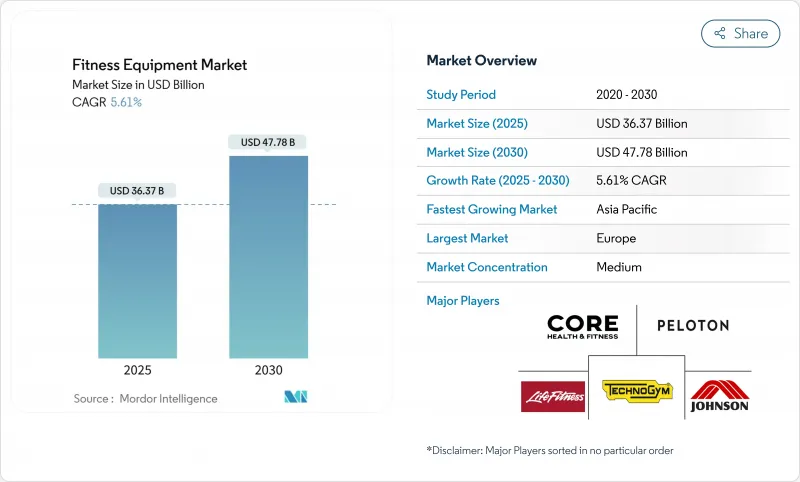
|
市場調査レポート
商品コード
1851719
フィットネス機器:市場シェア分析、産業動向、統計、成長予測(2025年~2030年)Fitness Equipment - Market Share Analysis, Industry Trends & Statistics, Growth Forecasts (2025 - 2030) |
||||||
カスタマイズ可能
適宜更新あり
|
|||||||
| フィットネス機器:市場シェア分析、産業動向、統計、成長予測(2025年~2030年) |
|
出版日: 2025年07月09日
発行: Mordor Intelligence
ページ情報: 英文 130 Pages
納期: 2~3営業日
|
概要
フィットネス機器の市場規模は、2025年には363億7,000万米ドルに達すると予測され、予測期間中のCAGRは5.61%を記録し、2030年には477億8,000万米ドルに成長すると予測されています。

世界的な肥満の蔓延、運動不足による経済的負担の増加、予防ヘルスケアを推進する政策イニシアチブが、市場の需要を促進しています。メーカーは、従来のフィットネス機器の設計にデジタル機能を組み込むことで、データ主導でパーソナライズされたワークアウト体験に対する消費者の嗜好の高まりを活用しています。さらに、医療保険会社や雇用主は、長期的なヘルスケアコストを軽減するために、機器の購入を補助するようになってきています。アジア太平洋地域では、急速な都市化と可処分所得の増加が、初めての機器購入に大きく貢献しています。一方、欧州では、成熟した市場インフラが、買い替えサイクルと技術アップグレードの需要を促進しています。競合情勢は依然として緩やかで、ニッチ・ブランドが市場シェアを拡大する機会を提供しています。環境に配慮した設計やコネクテッド・ハードウェア・エコシステムに特化した企業は、進化する消費者の嗜好や技術の進歩を活用する上で特に有利な立場にあります。
世界のフィットネス機器市場の動向と洞察
健康的なライフスタイルの影響力の高まり
ウェルネスは、一過性の動向から日常生活の基本的な側面へと進化し、多様な層のフィットネス機器需要の一貫した成長を牽引しています。米国スポーツ医学会(American College of Sports Medicine)の2025年フィットネス動向調査では、ウェアラブル・テクノロジーが世界の動向のトップに挙げられており、その普及が反映されています。伝統的な筋力トレーニングと高強度インターバル・トレーニングも依然として目立っており、器具を使ったフィットネス・ルーティンへの依存が続いていることが強調されています。このシフトは特に若い層で顕著であり、彼らはフィットネス機器を裁量で購入するのではなく、家庭のインフラに不可欠な要素だと考えるようになっています。現代のライフスタイルにおいて持続可能性への関心が高まっていることから、環境に配慮した機器設計やエネルギー効率の高い技術へのニーズがさらに高まっており、環境に配慮した健康増進への取り組みが広く反映されています。
肥満と生活習慣病の蔓延
世界的な肥満の流行は著しくエスカレートしており、現在10億人以上が肥満とともに暮らしています。この急増は、効果的な介入策に対するかつてない需要を生み出しています。WHOの欧州地域肥満報告書によると、2024年には5歳未満の子どものうち3,500万人が肥満と分類されます。さらに2022年には、5歳から19歳の子供と青少年の3億9,000万人以上が太りすぎで、そのうち1億6,000万人が肥満とともに暮らしています。WHOは、2030年までに新たに5億人近くの非伝染性疾患を発症し、世界経済に約3,000億米ドルの損失をもたらすと予測しており、その経済的影響は甚大です。ヘルスケアシステムは、体系化されたエクササイズ・プログラムを医療介入に組み込む傾向を強めており、フィットネス器具がもはや単なるレクリエーションとしてではなく、重要なヘルスケア・ツールとして捉えられるようになってきています。
高度なフィットネス機器の高価格
技術的に先進的なフィットネス機器の高価格は、特に価格に敏感なセグメントや、可処分所得が限られている新興国において、市場浸透の大きな障壁となり続けています。2024年には、大衆市場セグメントが市場シェアの68.46%を占めるが、依然として値ごろ感という課題に制約されています。こうした課題は中間所得層で最も顕著であり、潜在成長率は最大だが経済的な制約に直面しています。さらに、サプライチェーンの途絶と部品不足が続くことによる製造コストの上昇が、業界全体の価格圧力を強めています。メーカー各社は、高度な機能の搭載と市場へのアクセスの確保とのバランスを見極める必要に迫られています。さらに、米国消費者製品安全委員会が2025年7月に発効を予定している据置型アクティビティセンターの安全基準の更新により、コンプライアンスコストが増加し、機器の価格設定にさらに影響を与えることが予想されます。手頃な価格を改善するための潜在的な解決策として、融資オプションやサブスクリプションモデルが台頭してきているが、規制の複雑さや厳しい与信要件によってその有効性は制限されており、より幅広い市場参入の妨げとなっています。
セグメント分析
2024年、トレッドミルの市場シェアは26.43%を占め、様々な年齢層やフィットネスレベルに幅広くアピールしています。この優位性は、ウォーキング、ランニング、リハビリテーション、フィットネスメンテナンス、パフォーマンストレーニングなどの活動をサポートする多用途性に起因しています。トレッドマシンには、管理された測定可能なエクササイズ体験を提供する能力があり、簡単に追跡・調整できるため、目に見えるフィットネス成果を優先する目標志向の消費者にアピールしています。さらに、トレッドミルに対する親しみが定着していることで、消費者の購入へのためらいが軽減されます。オーストラリア政府はエクササイズバイクの安全ガイドに見られるように、エクササイズ機器の安全基準に重点を置いており、トレッドミルのデザインにおける安全機能の重要性を強調しています。
筋力トレーニング機器は、2025-2030年のCAGRが5.97%と予測され、最も急成長している分野です。この成長の原動力は、消費者が筋肉増強と機能的フィットネスに大きくシフトし、レジスタンスベースのワークアウトに重点を置いていることです。筋力トレーニングへの注目の高まりは、フィットネス科学の進歩に沿ったものであり、特に高齢化社会においては、代謝の改善、骨密度の維持、ケガの予防に重要な役割を果たすことが強調されています。このセグメントは、フリーウェイトから高度なレジスタンス・マシンに至るまで、多種多様な機器の恩恵を受け、メーカーは多様な価格帯と空間要件に対応することができます。
2024年には、従来型機器が75.45%の圧倒的な市場シェアを占め、機械的信頼性、メンテナンスの軽減、費用対効果を優先する消費者にとって魅力的であることを強調しています。これらの特性は、予算重視の購買層や、デジタルの機能強化よりも耐久性を重視する営利団体と共鳴します。このセグメントの堅牢性は、試行錯誤を重ねた技術に依存していることに起因しており、ソフトウェアの更新、接続の不具合、デジタル陳腐化の脅威といった、スマート機器にありがちな懸念事項を排除した一貫した性能を保証しています。
スマート機器とコネクテッド機器は急速な成長を遂げており、2025年から2030年までのCAGRは6.33%で成長すると予測されています。この急成長に拍車をかけているのは、より大きな健康とウェルネスの枠組みにシームレスに織り込まれた、テーラーメイドのデータ中心のフィットネス体験を求める消費者の欲求の高まりです。この分野が洗練され、従来のものと一線を画していることの証左は、EGYMが2025年に展開する、AIを活用したワークアウトのパーソナライゼーションとカメラによる3D変動分析です。コネクテッド機器の領域は、健康データの統合に向けた広範な動きの波に乗っています。
地域分析
2024年には、欧州が39.42%の最大市場シェアを占め、先進的なフィットネス・インフラ、高い可処分所得水準、予防医療を重視する強固なヘルスケア制度がその原動力となっています。同地域の規制枠組みは、公衆衛生の優先事項として身体活動を積極的に推進しており、市場をさらに強化しています。この地域は、確立されたジム文化や、身体活動を奨励する政府のイニシアチブの恩恵を受けています。2023年のWHO/OECDの報告書では、身体活動を増やすことでEUは年間80億ユーロ近くのヘルスケアコストを削減できると強調されており、フィットネス機器導入への政策的支援が強化されています。数十年にわたるフィットネス文化の発展により、欧州は市場のリーダーとしての地位を確立しており、ドイツ、イタリア、フランスなどの国々は、身体活動不足による大きな経済的負担に直面しています。このことは、有利な市場機会を生み出すと同時に、こうした課題に対処するための喫緊の政策的焦点にもなっています。
アジア太平洋地域は、2025~2030年のCAGRが7.54%と予測され、急成長地域として浮上しています。同地域の成長の原動力となっているのは、急速な都市化、可処分所得の増加、健康意識の高まり、政府主導の身体活動促進策です。こうした要因が、市場開拓のレベルが異なる市場全体の需要を牽引しています。この成長軌道の顕著な例として、ジョンソンヘルステックがベトナムの新工場に1億米ドルを投資し、2025年第1四半期に着工、2026年までに操業を開始する予定であることが挙げられます。この投資は、この地域がフィットネス機器の製造拠点として、また消費地として成長していることを強調しています。
北米は、家庭でのフィットネス普及と高級機器志向を特徴とする成熟市場です。可処分所得の高さと充実したフィットネス・インフラがこの動向を支えています。この地域はコネクテッド・フィットネス分野のパイオニアであり、Pelotonのような企業が最初にこのカテゴリーを定義しました。しかし、市場の飽和と競合の激化が、こうしたプレーヤーに課題をもたらしています。南米では、都市化と中間層の拡大が新興市場のダイナミクスを牽引しています。一方、アフリカと西アジアは、インフラの制約と経済変動が主要な制約となっているもの、大きな成長の可能性を示しています。世界的には、世界保健機関(WHO)の報告によると10億人以上が罹患している肥満の蔓延が、フィットネス・ソリューションに対する普遍的な需要を牽引しています。しかし、市場へのアクセスは、購買力や市場開拓のペースといった要因によって左右されます。
その他の特典:
- エクセル形式の市場予測(ME)シート
- 3ヶ月間のアナリスト・サポート
よくあるご質問
目次
第1章 イントロダクション
- 調査の前提条件と市場の定義
- 調査範囲
第2章 調査手法
第3章 エグゼクティブサマリー
第4章 市場情勢
- 市場概要
- 市場促進要因
- 健康的ライフスタイルの影響力の高まり
- 肥満と生活習慣病の増加
- 機器製造における技術の進歩
- ホームフィットネス人気の高まり
- ハイブリッドで柔軟なフィットネスモデル
- ソーシャルメディアとフィットネス・インフルエンサーの影響力
- 市場抑制要因
- 先進フィットネス機器の高コスト
- アウトドア志向
- 家庭用機器のスペースの制約
- メンテナンスの複雑さと高いアフターセールス・コスト
- 消費者行動分析
- 規制の見通し
- ポーターのファイブフォース分析
- 供給企業の交渉力
- 買い手の交渉力
- 新規参入業者の脅威
- 代替品の脅威
- 競合の程度
第5章 市場規模と成長予測
- 製品タイプ別
- トレッドミル
- エリプティカルマシン
- 据置型サイクル
- ローイングマシン
- 筋力トレーニング機器
- その他の製品タイプ
- カテゴリー別
- 従来型
- スマート/コネクテッド機器
- 最終用途別
- 住宅用
- 商業用
- 価格帯別
- マス
- プレミアム
- 流通チャネル別
- オフライン・チャネル
- オンライン・チャンネル
- 地域別
- 北米
- 米国
- カナダ
- メキシコ
- その他北米地域
- 欧州
- ドイツ
- 英国
- イタリア
- フランス
- スペイン
- オランダ
- ポーランド
- ベルギー
- スウェーデン
- その他欧州地域
- アジア太平洋地域
- 中国
- インド
- 日本
- オーストラリア
- インドネシア
- 韓国
- タイ
- シンガポール
- その他アジア太平洋地域
- 南米
- ブラジル
- アルゼンチン
- コロンビア
- チリ
- ペルー
- その他南米
- 中東・アフリカ
- 南アフリカ
- サウジアラビア
- アラブ首長国連邦
- ナイジェリア
- エジプト
- モロッコ
- トルコ
- その他中東・アフリカ地域
- 北米
第6章 競合情勢
- 市場集中度
- 戦略的動向
- 市場シェア分析
- 企業プロファイル
- Technogym S.p.A.
- Johnson Health Tech Co. Ltd.
- Life Fitness LLC
- Core Health & Fitness LLC
- Peloton Interactive Inc.
- Icon Health & Fitness, Inc.
- Dyaco International Inc.
- Hoist Fitness Systems, Inc.
- True Fitness Technology Inc.
- Woodway USA, Inc.
- Coulter Ventures, LLC(dba Rogue Fitness)
- Torque Fitness LLC
- Echelon Fitness Multimedia LLC
- Tonal Systems Inc.
- Hydrow Inc.
- Concept2 Inc.
- JERAI Fitness Pvt. Ltd.
- Body-Solid, Inc.
- Powermax Fitness(I)Pvt. Ltd.
- VINEX Enterprises Pvt. Ltd.

